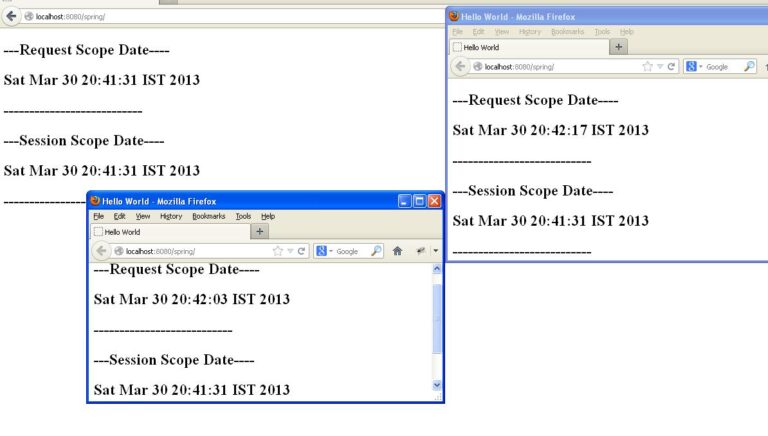A Spring process follows bean based approach.The Spring bean is created, managed and dispensed by the Spring IoC container. Each Spring bean has a lifecycle and the lifecycle has to undergo the following stages: Instantiate – The Spring container instantiates the bean. Populate properties- Spring IoC container injects the bean’s properties. Set Bean Name- Spring …
Custom Scope for Spring Beans
In my previous posts Spring bean scopes (Singleton and Prototype) with example and Spring bean scopes (Request, Session, Global Session) with example I discussed about the bean scopes in spring. There’s one more scope which I forgot to mention, its the Thread scope. The spring documentation states that As of Spring 3.0, a thread scope …
Spring bean scopes (Request, Session, Global Session) with example
When you define a bean in the configuration file, you are just defining the structure of the bean or it is just a class. With that definition, you can create any number of instances. Here the advantage of the bean is that, you are not only allowed to define the dependencies for the beans, you …
Spring bean scopes (Singleton and Prototype) with example
When you define a bean in the configuration file, you are just defining the structure of the bean or it is just a class. With that definition, you can create any number of instances. Here the advantage of the bean is that, you are not only allowed to define the dependencies for the beans, you …
Hibernate Many-To-Many Mapping Example (XML Mapping)
In this tutorial we will write a simple Java project to demonstrate Hibernate Many to Many Mapping using XML mapping. We will first create a Java project using Maven and then will add Hibernate on it. If you have any questions, please post it in the comments section. If you are interested in receiving the …
Hibernate One-To-Many Mapping Example Using Annotations
In this tutorial we will write a simple Java project to demonstrate Hibernate one to Many Mapping using Java Annotations. In my previous article I have explained Hibernate one to Many Mapping using XML. The main difference between these two examples would be the hibernate configuration files and annotations. Otherwise both the articles trying the same …
Hibernate One-To-Many Mapping Example (XML Mapping)
In this tutorial we will write a simple Java project to demonstrate Hibernate one to Many Mapping using XML mapping. We will first create a Java project using Maven and then will add Hibernate on it. If you have any questions, please post it in the comments section. If you are interested in receiving the …
Hibernate One-To-One Mapping Example Using Java Annotations
In this tutorial we will write a simple Java project to demonstrate Hibernate one to one Mapping using Java Annotations. We will first create a Java project using Maven and then will add Hibernate on it. If you have any questions, please post it in the comments section. If you are interested in receiving the …



